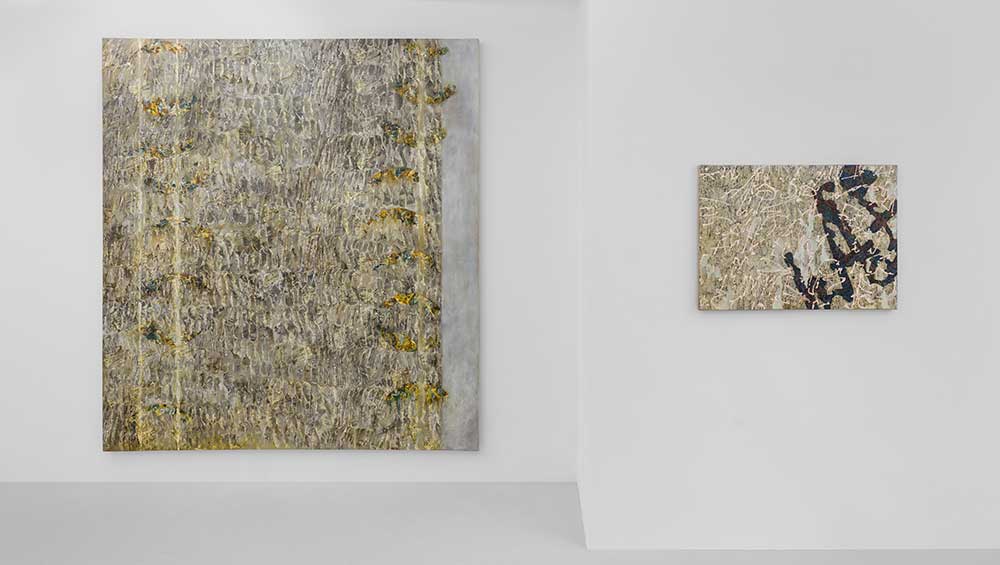
Thérèse Oulton, installation view, Vardaxoglou Gallery, London, 2024.
Vardaxoglou Gallery, London
30 August – 4 October 2024
by SAM CORNISH
At Vardaxoglou Gallery is a bewitching, challenging and revelatory exhibition of paintings from the last 40 years of Thérèse Oulton’s output. Across two small spaces, a dozen works are arranged visually rather than chronologically and provide a succinct introduction to an artist who has a surprisingly low profile, despite being represented by Marlborough Gallery for three decades before its recent closure. Living and working in London, her previous solo exhibition here was in 2014.
Oulton’s early career is shown by three small paintings made between 1983 and 1985, shortly after her time as a postgraduate student at the Royal College of Art. These are images that return to and linger among the roots of modern art. Their spaces are rich and shifting, implying shadowy interiors or encased in nocturnal or arboreal gloom. The mysteriousness of Romantic or symbolist painting is accompanied by some of their accoutrements. There are glimpses of the metallic sheen of armour seen through darkness, a murky path, a wavering candle, heavy red fabric, a spiral staircase of uncertain destination. Fuseli’s The Nightmare (1781) perhaps, in which the characters have left the stage or been almost fully absorbed into exploratory darts and scumbles of paint.
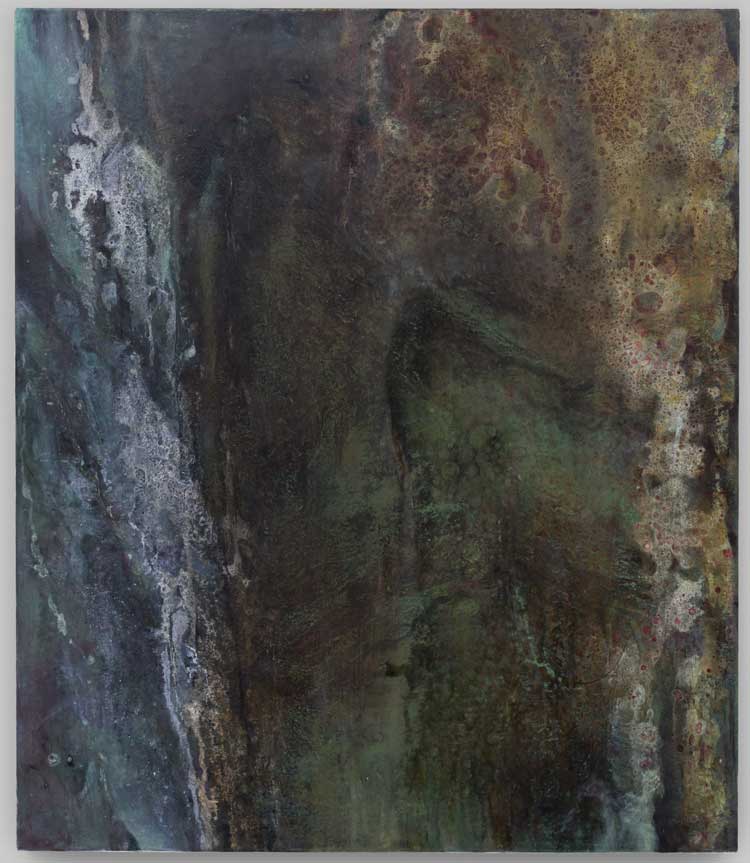
Thérèse Oulton, Ash, 2024. Oil on linen, 71 x 61 cm (28 x 24 in). Courtesy the artist and Vardaxoglou Gallery, London.
In their ambiguous embrace of figurative imagery and their implicit rejection of a linear, progressive model of abstract painting, Oulton’s early works accord with the attitudes brought to prominence by the Royal Academy’s 1981 exhibition A New Spirit in Painting, staged while she was a student. There are certainly parallels with Per Kirkeby or Anselm Kiefer (although I am told her only long-term artist friend is Gerhard Richter). But, crucially, there is not the tendency to self-aggrandising gesture that was a central feature of neo-expressionism. Perhaps the hint of portentousness in these early works would be more pronounced if larger examples had been shown, but Oulton appears motivated by genuinely private impulses. They bring to mind, in a highly compelling way, Kandinsky’s enigmatic aphorism: “speaking of the hidden by means of the hidden. Is this not content?”
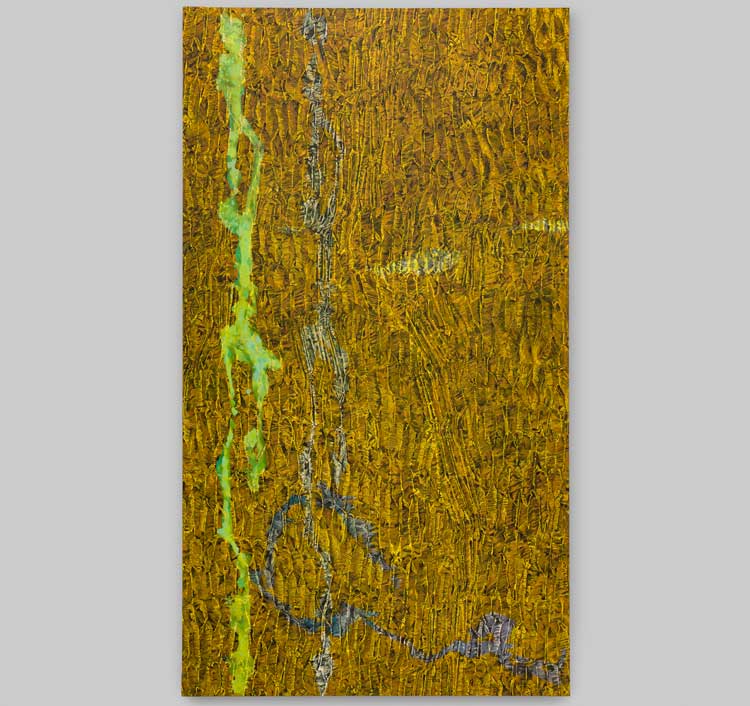
Thérèse Oulton, Shadow of a Doubt, 1995. Courtesy the artist and Vardaxoglou Gallery, London.
The impression of a private trajectory is borne out in the paintings that follow in the 90s and early 00s. These are the core of the exhibition and for me its highlight. The impetuous brushwork of the early paintings is tempered, tightened and toughened, brought under rhythmic control. The imagery is abstract, although a sense of the natural world remains in tone and pattern. But it is nature figured or recognised as strange, at the least remote from everyday experience, or even located in some realm cut off from the human. The dark luminescence of Shadow of a Doubt (1995) accompanies an obsessive, almost airless density. The paths, stairways and dimly lit spaces of the early paintings suggest points of entry, despite their mysteriousness. The later work does not provide any easy places for the viewer to stand. After a while looking at them, I caught myself shifting from side to side and craning my neck, as if I were subconsciously trying to see round or behind the image, and there discover the key to its mystery.
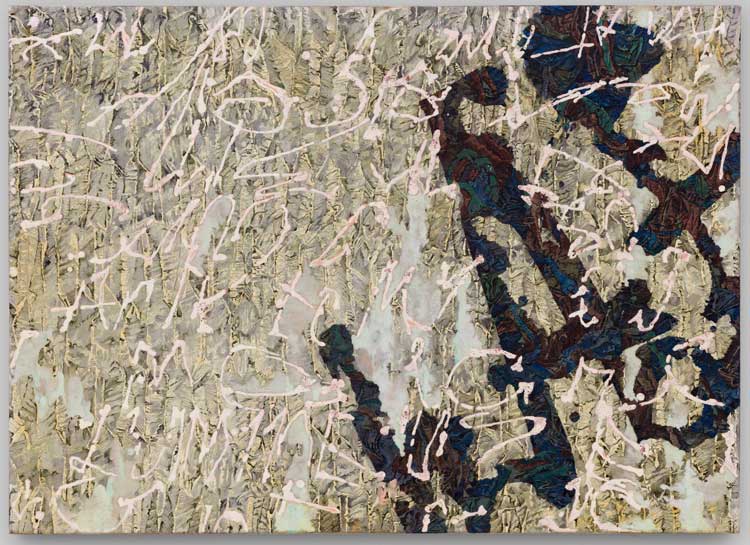
Thérèse Oulton, Score 3 (Paris), 1996. Courtesy the artist and Vardaxoglou Gallery, London.
These are paintings that resist being taken in at first glance, in which (as per Kandinsky) meaning is created through being withheld. Much modernist abstract painting valued speed and immediacy of making and perception. Part of the potency of a Jackson Pollock is the sense we encounter the image all-at-once, as a vision or revelation, out of which then flows a more extended, complex understanding. Oulton’s Score 3 (Paris) (1996) functions in a very different way, despite its calligraphic similarity to Pollock. Its illegible script at first glance appears fluidly written, then perhaps seems gorged into the surface, but in fact has been carefully and methodically painted. An initial impression of speed is completely subverted, as is a clear sense of cause and effect. After some scrutiny, we can identify the painting’s precise but disjunctive layers, but how or why they have been brought together, or even which one precedes the other, remains elusive.
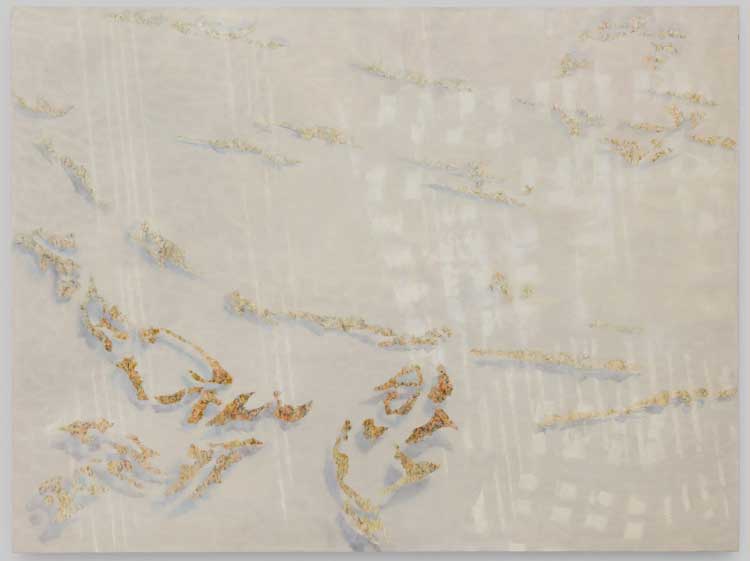
Thérèse Oulton, Apparition, 2003. Oil on linen, 139.1 x 182.2 cm (54 3/4 x 71 3/4 in). Courtesy the artist and Vardaxoglou Gallery, London.
Apparition (2003) is shown in the gallery’s naturally lit space upstairs, neatly in harmony with the painting’s light-filled openness. Here, space is described with more fully representational means, that in consequence comes close to surrealism. It is unclear whether we are looking down across a wide plain or at the patterns of light falling through a windowpane on to a wall or floor: near and far are brought together. Across this highly ambiguous arena are arrayed a network of strange, faintly biomorphic shapes, perhaps fragments of the dense network that fills paintings such as Shadow of a Doubt, each element supported by its clearly rendered shadow. The sense of unsettling paradox at the heart of Oulton’s image-making remains, despite the ostensibly serene aura it is here bathed in. The two most recent paintings in the exhibition, both dated this year, appeared slight in comparison, their dark, smooth-surfaced fluidity lacking the compressed complexity of the paintings of 10 or 20 years earlier. Yet even these are paintings I would like to see more of, and perhaps if seen in greater numbers would suggest their own hidden depths.